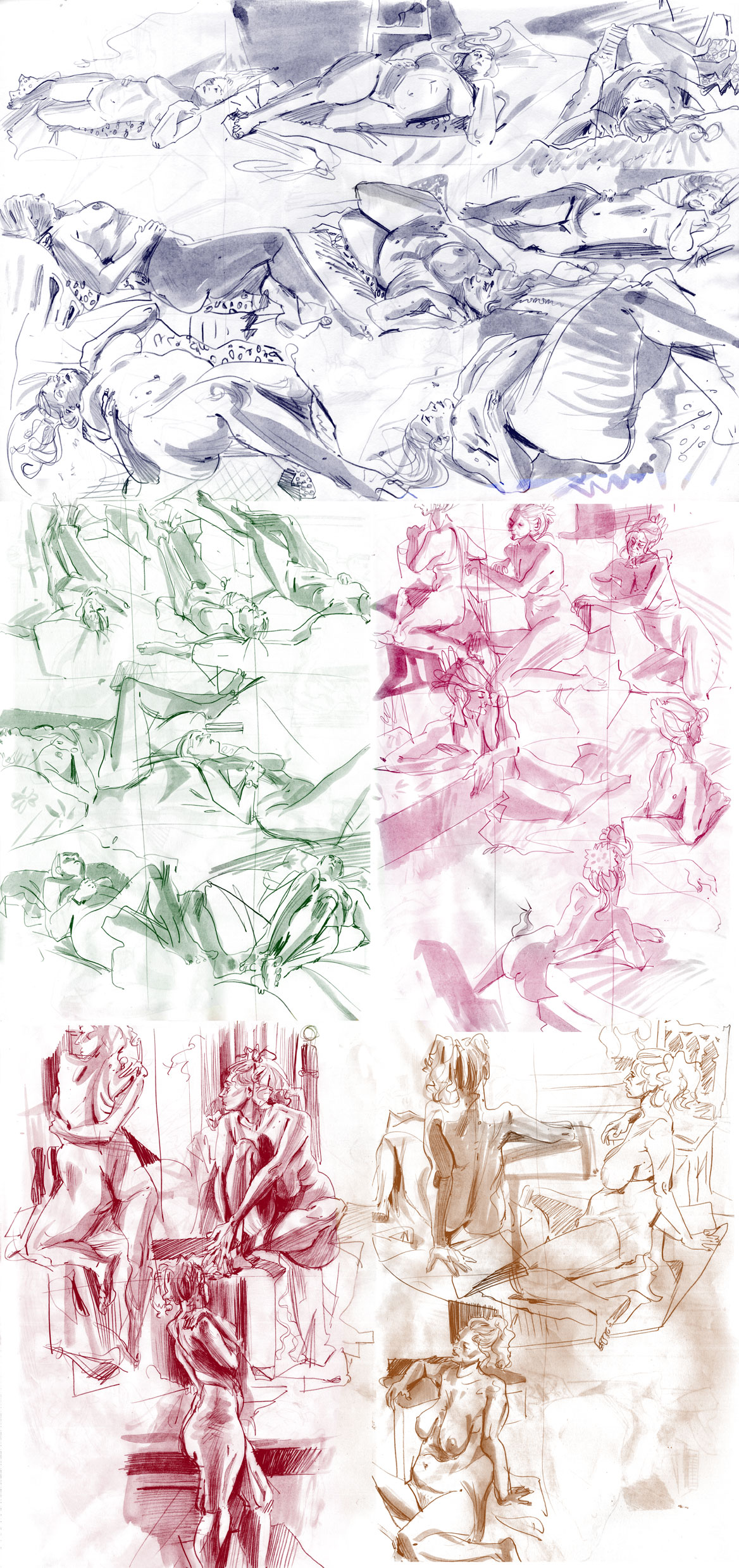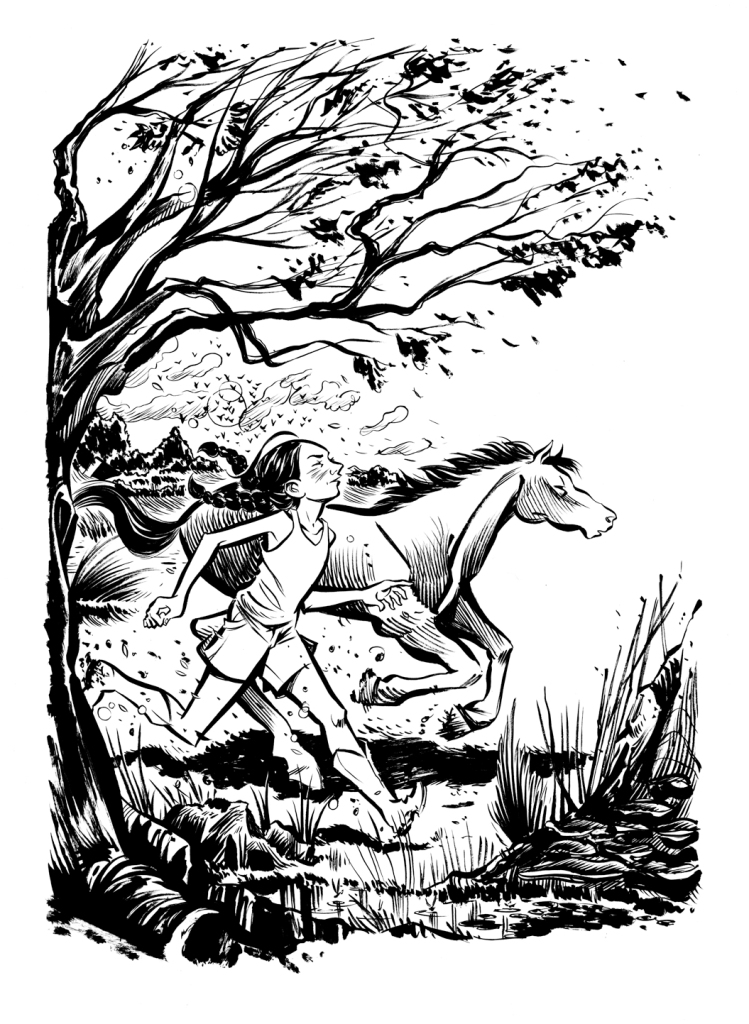Filed under: drawing, drawing theory, illustration, illustrations, sketchbook, writing | Tags: art, children's books, draw daily, drawing, illustration, sketch, sketchbook, sketchbook inspiration, sketching, south africa, travel diary, travel sketchbook, travelogue, watercolour

(Cross-post with Wild Tomorrow blog.)
In 2023 I was asked along on a volunteer trip for conservation with Wild Tomorrow. At the time, I hadn’t heard of Wild Tomorrow and I confess: I had no idea what I was signing up for.
I’m an illustrator and a bit of a writer, and was set to go to the wildlife reserves of KwaZulu-Natal in the east of South Africa for two weeks as part of CBCC (Children’s Books Creators for Conservation, founded just this year by Hayley and John Rocco), ostensibly with the aim of conducting visual research in sketchbooks for a potential book about the subject of wild animal conservation.
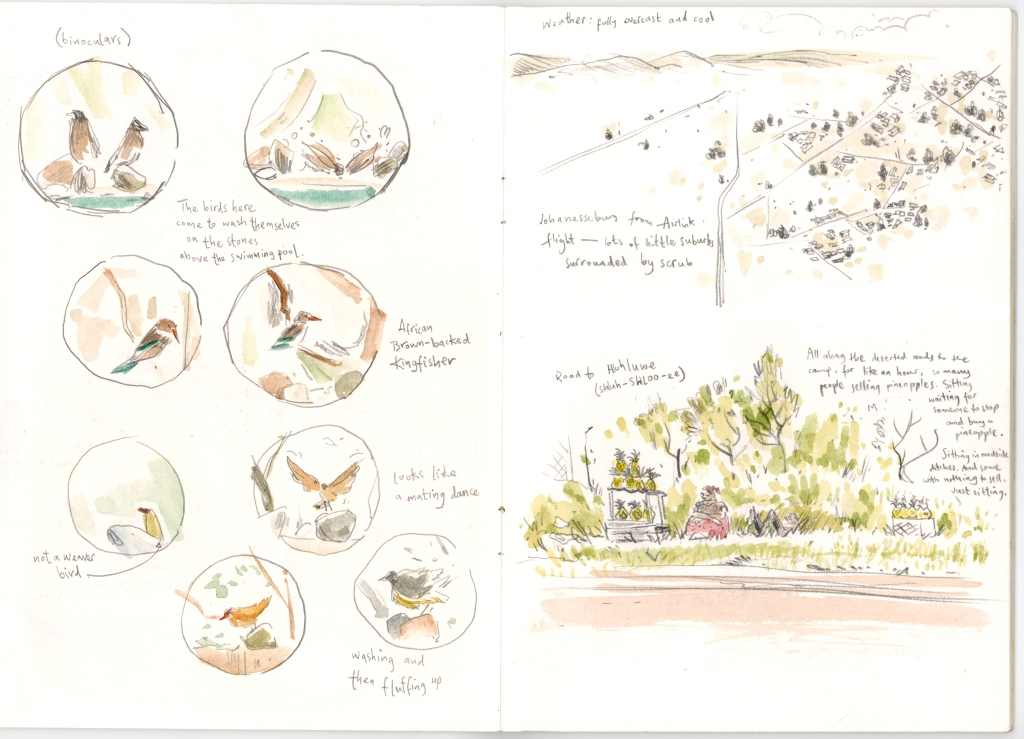
Being kind of travel-phobic I approached the trip with some uncertainty. What would these two weeks involve, really? I wasn’t sure. We were provided with an itinerary, which detailed the facts of the unbelievable things we would be doing each day, but these things seemed so far away: what did they really mean?
Sat behind a computer screen in drizzly England, it was hard to think of more than a tourist cliché of ‘go to place, see animals, be amazed.’ And I was worried that I might not be amazed enough, that my heart might not be able to go somewhere so big.
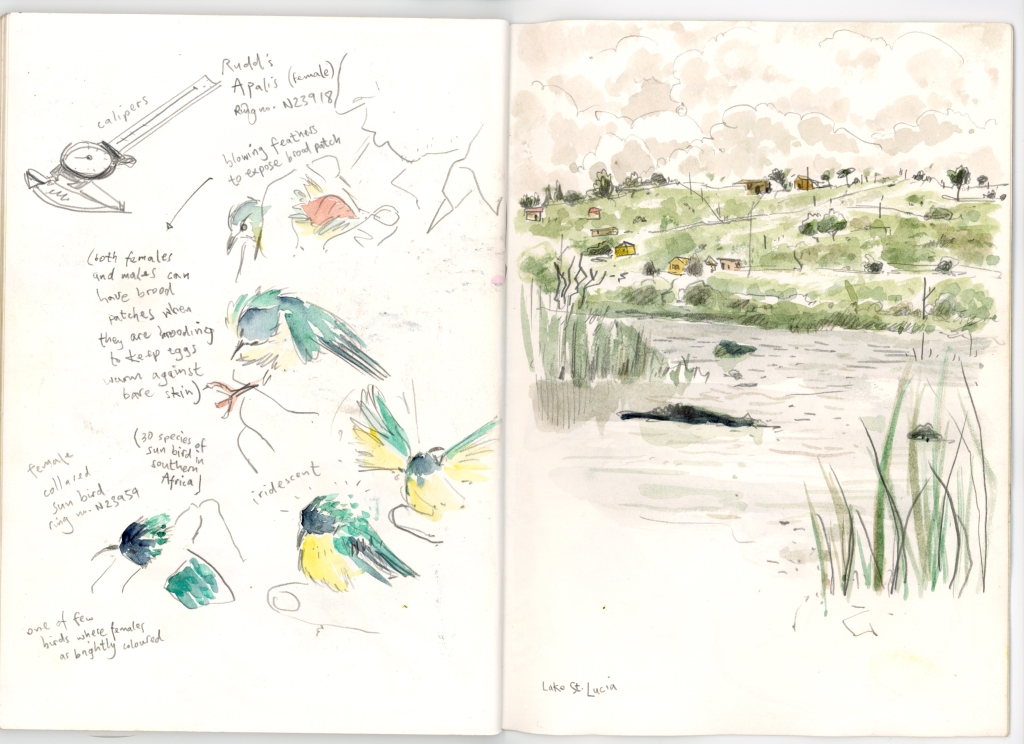
Before this year, I had never had any intention of going to South Africa or seeking out the famous animals of the country, and I’d certainly never been on a trip of this sort. So the opportunity came without preconceptions, and without any notion of what I could contribute, or what I could take from the experience.
This feeling continued even after touching down in Johannesburg and meeting all the lovely, enthused people I would be spending the next two weeks with. ‘Everyone else seems to know what they’re doing here,’ I thought to myself, ‘And I’m not sure that I do.’

But as the days went on, I found myself gradually overwhelmed by the strange new life that Tori and the Wild Tomorrow crew invited us into. In spite of my own hang-ups and misgivings, the country and its people began pulling me into their world, and by the second week, my mind and my heart had been blown wide open, and in time, I began to understand why I was there.
I wasn’t the only one. In conversations with others, I heard similar concerns: being unsure if coming on the trip was a constructive thing, and whether one had something to contribute to the group effort. I guess it’s more natural to have these doubts than I realised. But the doubts we had began to be overtaken by the undeniable optimism of what we were involved with.
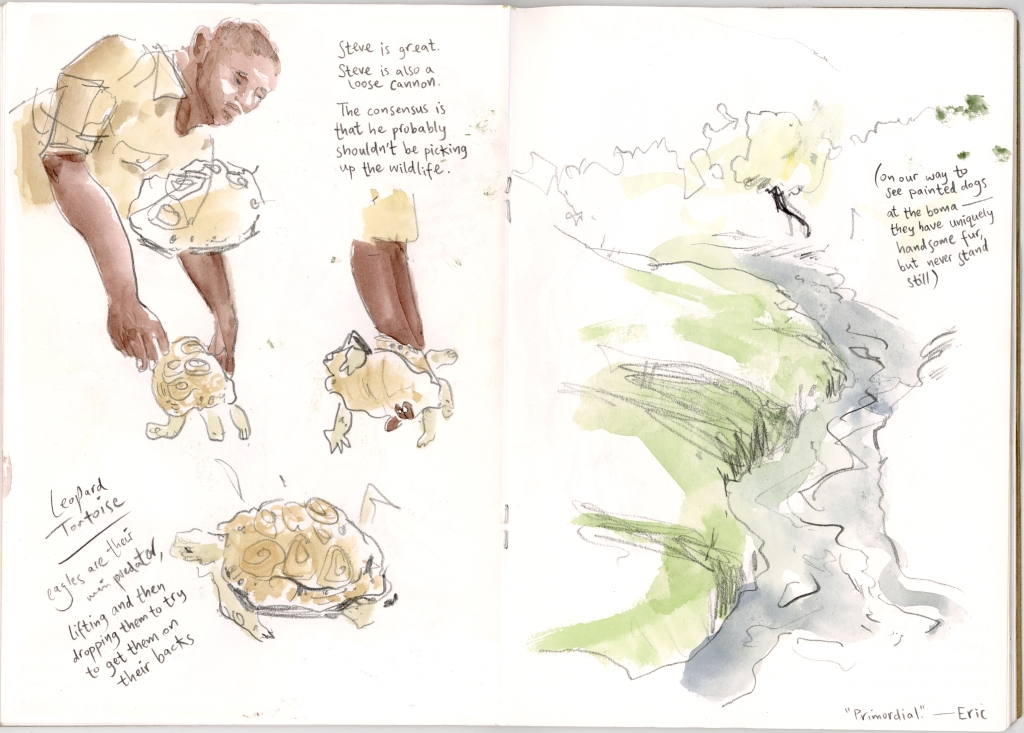
Though I had begun the trip hidden behind my sketchbook, my immersion in the place became such that by the first weekend I neglected to draw for a couple of days, stunned and simply taking it all in and enjoying getting to know everyone.
But then, remembering the intended purpose of the trip, I returned to my drawing and note-taking with a renewed vision: that I could use the sketchbook to communicate my emotional and totally subjective experience of the beauty and importance of the threatened natural world, as well as the people working to protect it.
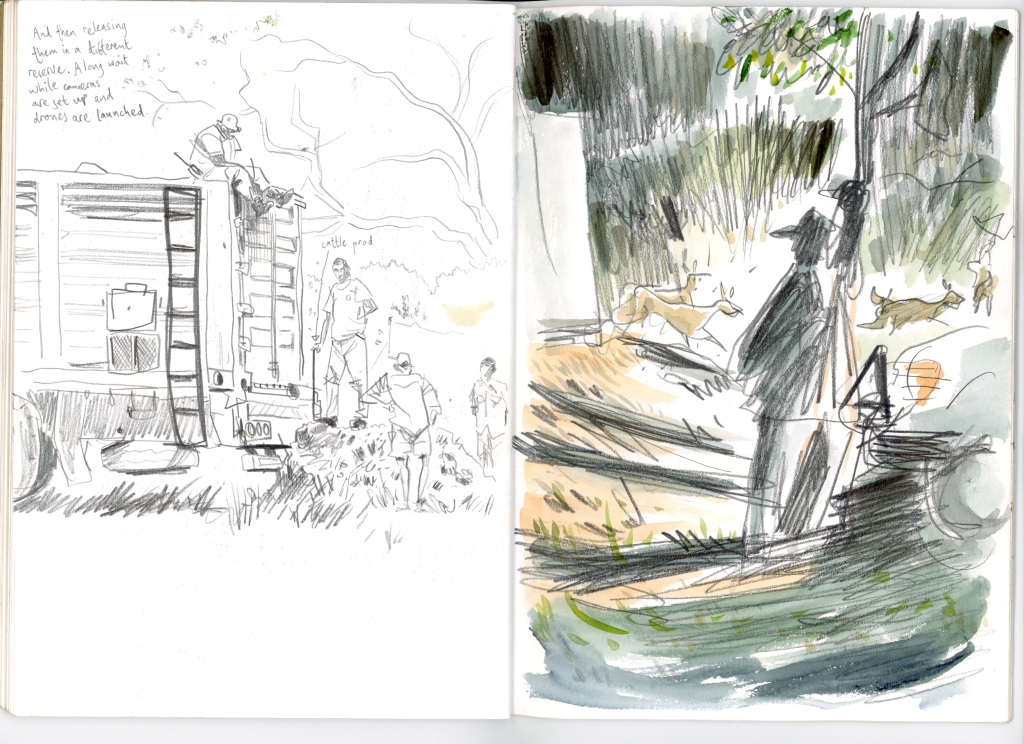
Compared to the tireless work of those who wake up every day and go out there on this mission, I do have to wonder what small part my abilities can contribute to the cause of conservation. But when I experienced the response people had to my drawings, I began to understand the importance of communicating experience, and that there can be something specially significant about a drawing or a very personal piece of writing.
I was even more fortunate to be travelling with fellow book creators as part of CBCC, and had the companionship of sketching alongside wonderful artists like Eric, Brian, and Jessica whose talent and experience and generosity of spirit were both humbling and an inspiration.
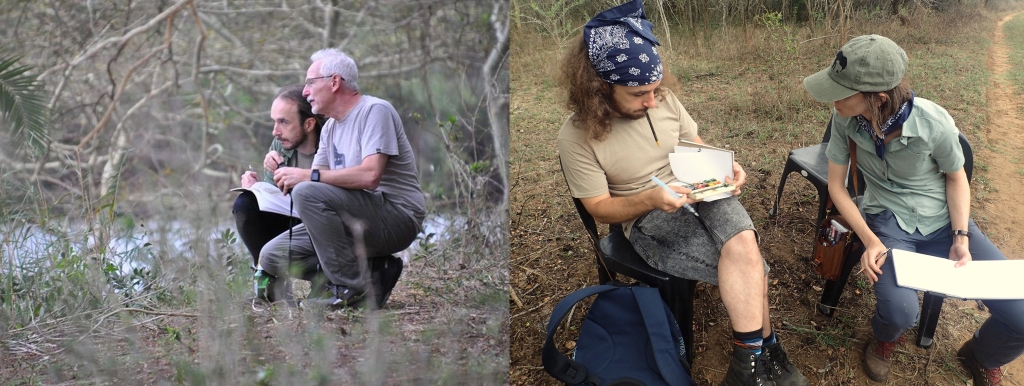
‘If I went in to this with a hamfisted idea of what conservation meant’, I thought, ‘Maybe other people have the same unclear or stereotypical vision of all this, and maybe I can share some of my dawning understanding with them.’
Can a drawing capture something that a photograph or a video can’t? Again and again people told me, yes, it can. Drawing opened up conversations with rangers, landowners, vets, locals, and fellow tourists from all over, and what wonderful conversations they were: driven by their love and awe for what was in front of us, a love and awe that they helped me to discover too.

I guess there’s a being there in drawing that people respond to. Someone asked me, ‘Why not take a photograph and draw it later?’ But that would only be drawing animals. And going into the experience, I had worried that drawing animals was all it would be.
But being there, and being a part of it, mattered. From people’s kind and open responses to what I was doing, I learned that by being there I could do much more than simply draw animals: I learned that I might be able to articulate something of how it feels to be there, in the trees where an elephant has fallen, to feel her heated breath, the pulse in her ears, the texture of her skin. And the mood, the tension, the atmosphere. And the determination and care of the people who do this work.

I see art as a way of communicating things that can’t be described in the ordinary ways. There are things we can feel and see that defy simple description, and we saw these things every day. I like to think that this is why poetry exists, to give us the means to articulate feelings that can’t be articulated.
I just hope that a little something of my appreciation for the dignity and vulnerability of these animals and these people, and these places, can come across in my drawings enough to inspire others to feel something of the understanding that dawned at these moments of intensity.

It would be tempting to tell everyone to go buy a ticket right now and hotfoot it to KwaZulu-Natal for two weeks with Wild Tomorrow (and if you’re an artist, a photographer, a poet, or simply a dreamer, then you should consider it if you can), but I also took away a broader message.
We go through many things in life, and each of us lives a different life. There are places you will go that I never will. You may live most of your life in a faraway city I yearn to visit but never will, with your own dreams and fears, ecstacies and heartbreak. We can each only live one life. But by keeping our eyes and our hearts open, and by making art in any way we can, I hope we can let each other in to our own subjective experiences, and see a little bit through each other’s eyes, and live a little bit of each other’s lives, and capture some essence of the fleeting moments in time that make us who we are, and finally understand one another.
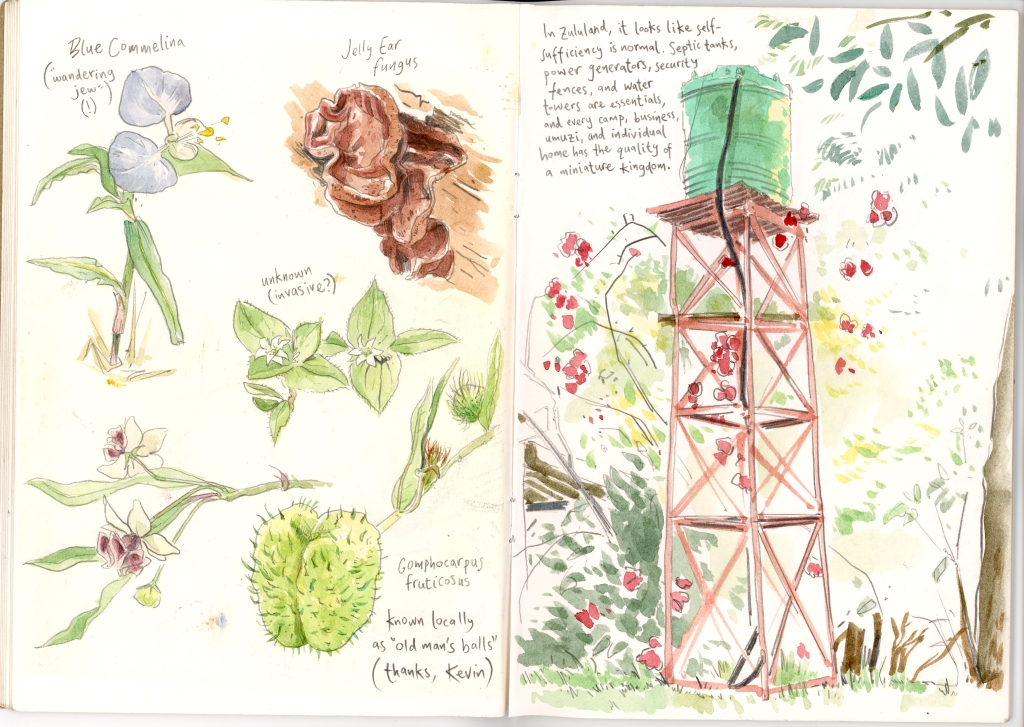
Although I went in as a clueless bystander, unconvinced that I had the spirit to rise to the experience, I found myself deeply moved by the things that the people at Wild Tomorrow worked tirelessly to make us a part of and by the glimpses that I had of the lives that go on there. My simple little sketchbook was merely a tool that helped to make this connection happen.
I still need to figure out how to develop all this into something that can contribute to Wild Tomorrow and the wider cause of public communication of conservation issues which is the mission of CBCC. But just going, and being there, was overpoweringly positive, and, I hope, the first step in something very good, and one of the most enriching and fortunate experiences of my life as an artist.
(Photos courtesy of Greg Neri and John Rocco.)
Filed under: amy & kay, comics, drawing, graphic novels, illustration, illustrations, my comics, writing | Tags: art, books, comics, illustration, sketch, writing
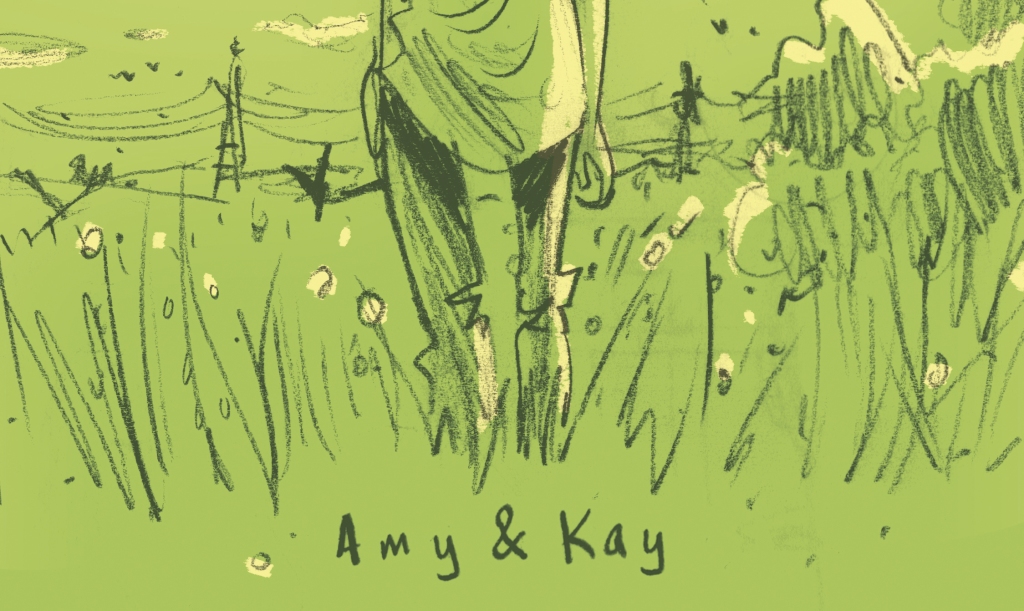
There’s a time in your early twenties when you start to realise that you’re not cool anymore.
You start to see all your friends getting real jobs, getting real relationships, moving into nice homes, and meanwhile, you’re still the same punk you’ve been since you were fourteen, the one who all the kids used to think was the coolest person in your local town, the one who everyone used looked up to, the one who always knew where to find a good time, but now you’re twenty-five and all of a sudden it seems like no-one cares anymore.
At least this is what it’s like for Amy and Kay. Life used to be so simple, but now it feels like everything’s slipping away. And when the painfully uncool Laura inserts herself into Amy’s life, it becomes painfully obvious that adulthood has arrived, and if Kay chooses to ignore it, who knows where she might end up…
I’ve been drawing this thing with a 4B pencil for a year or so now, fitting it in to spare days and watching it grow. As it nears completion, I thought I’d share a short scene from the second chapter. I’ve been gradually working on several graphic novels over the last few years. Call me scatterbrained, I can never seem to focus exclusively on one project. But Amy & Kay is getting close to completion at around two-hundred pages, and I can’t wait to share the complete story with everyone who’s ever wondered if they’re about to be left behind.
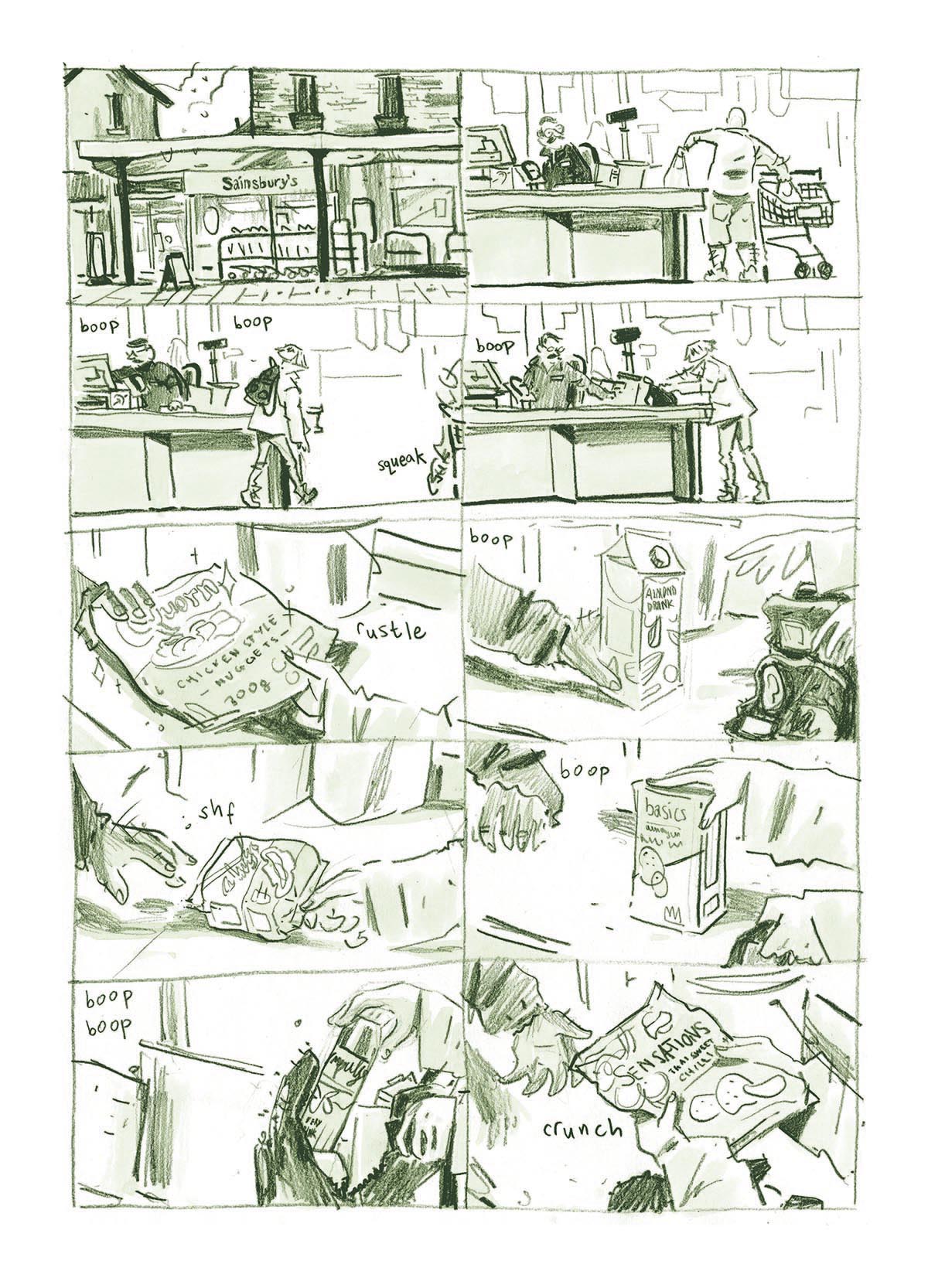
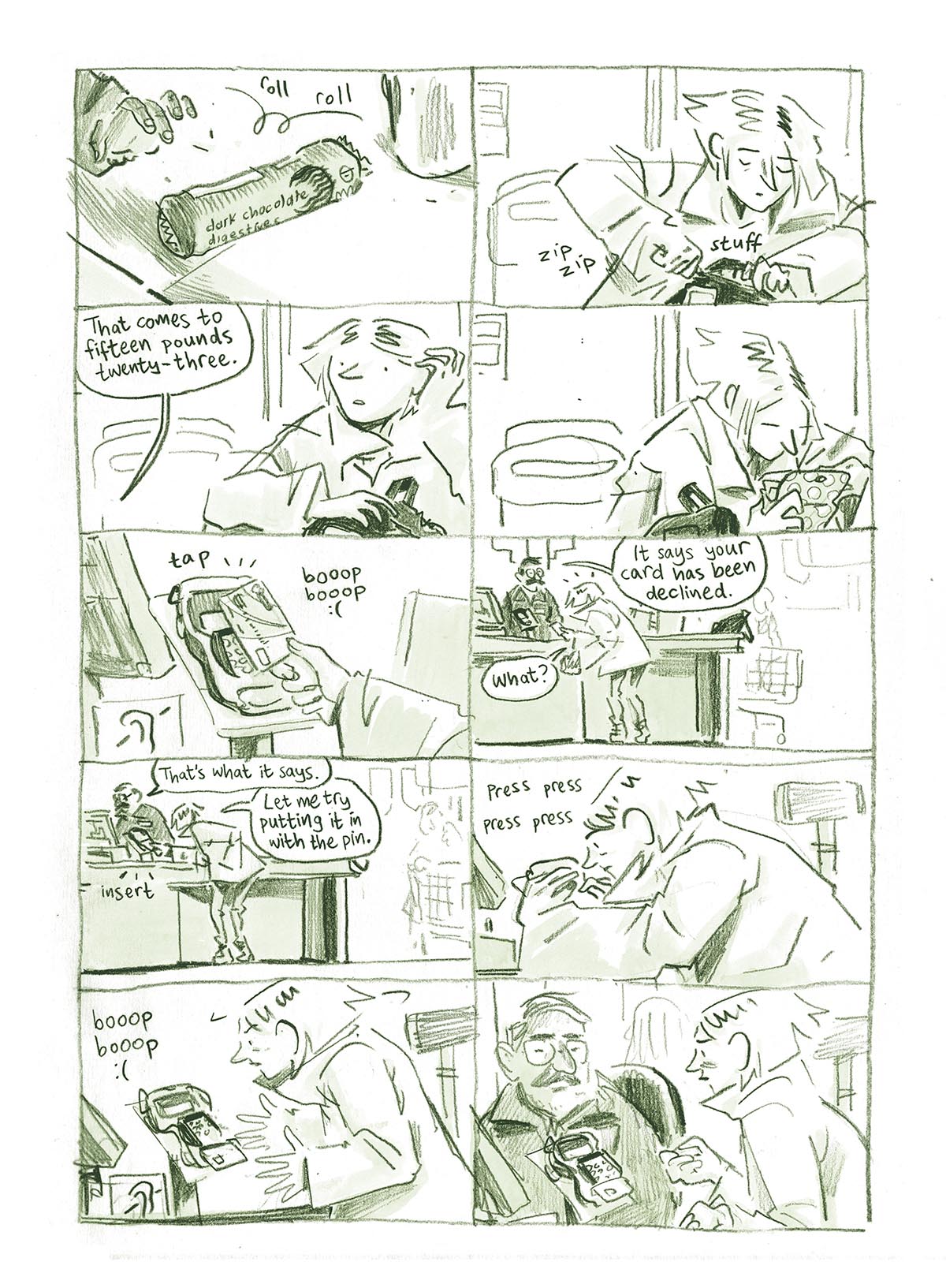

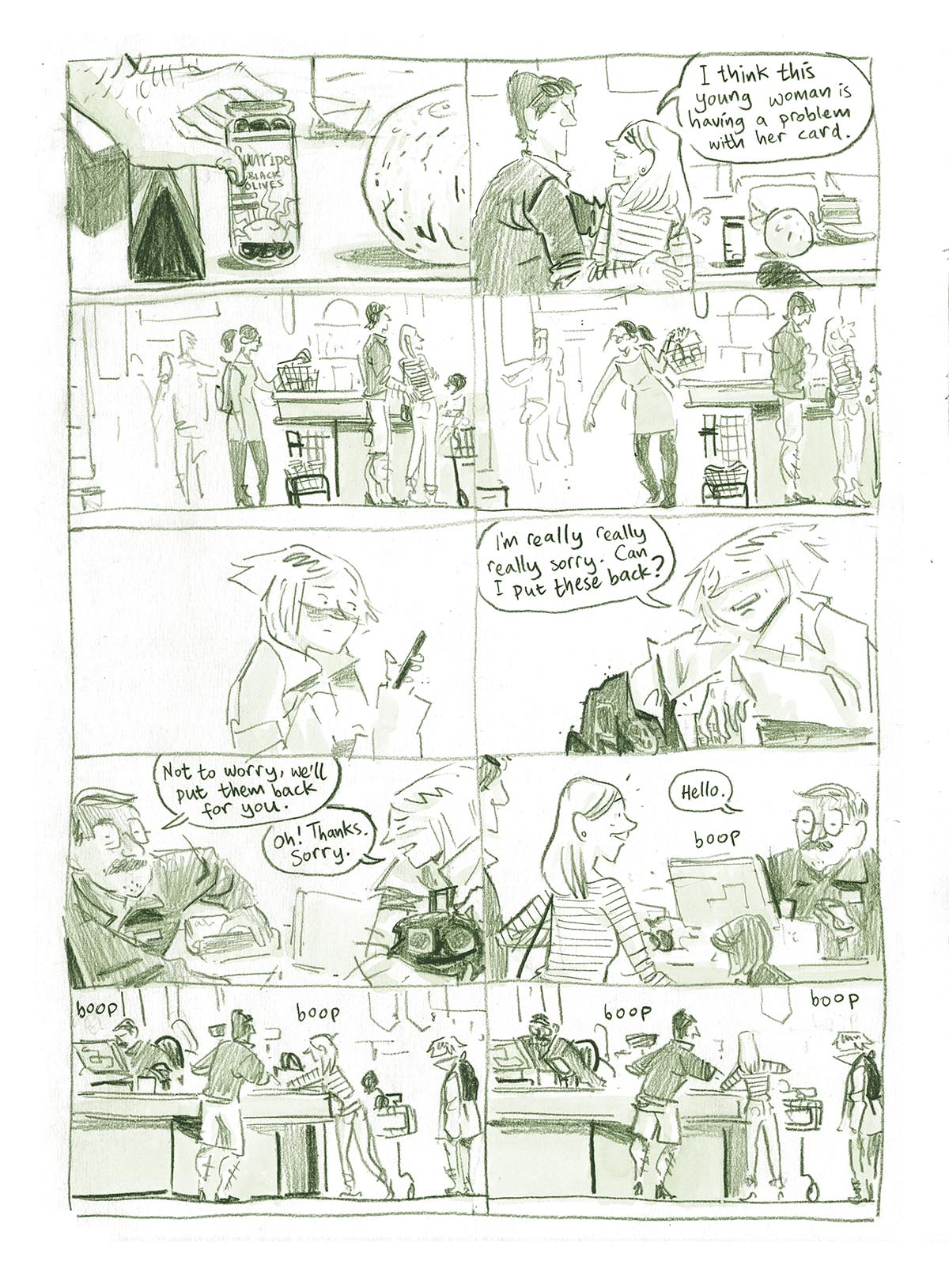
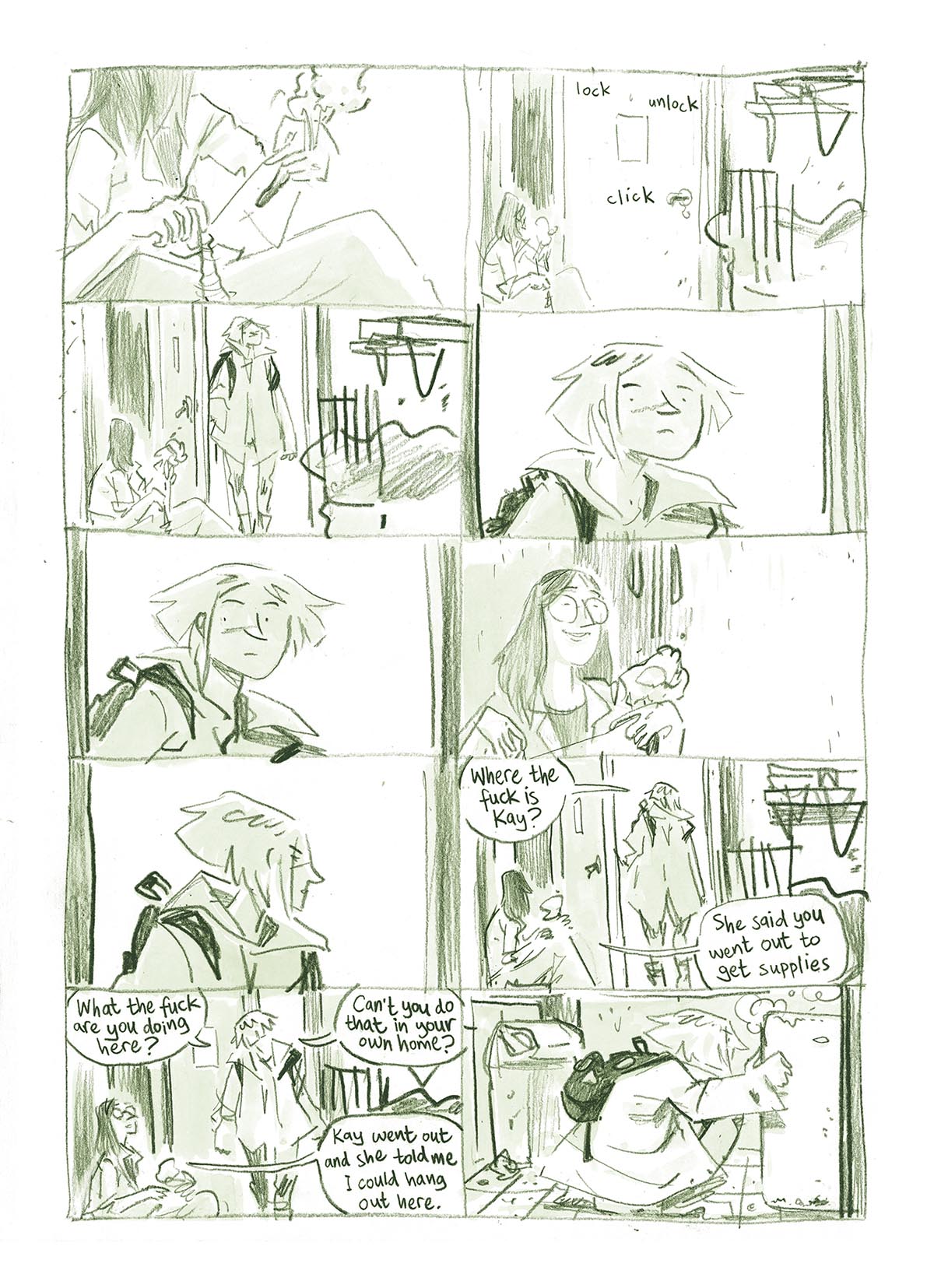
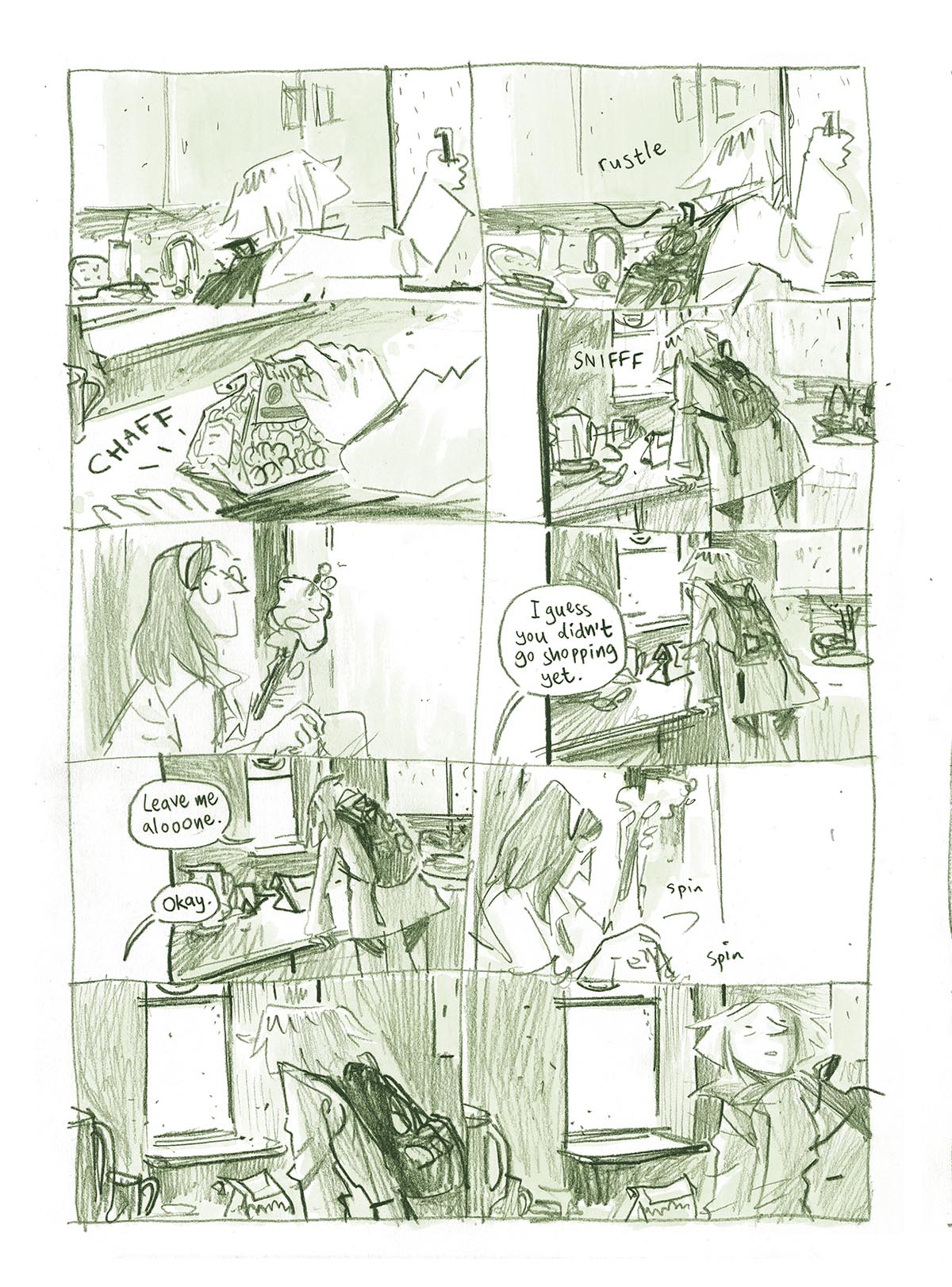

Filed under: illustrations | Tags: books, children's books, graphic novels, illustration, travel

Is it really beach time?
Currently working with some talented people on a travelogue like no other.
Comics and diagrams, fantasy and reality, maps and diaries, history and the modern day, illustrations and photographs. This book is bringing together so many of the cool things you can do when images and text get together.
So often we use categories like ‘picture book’, ‘graphic novel’, ‘illustrated novel’, book formats with their own specific rules and design principles: a set of things that are allowed. But recently, we’re starting to see more and more crossover between those different formats. If the only rule is, “It’s images, and it’s text, on a page,” the possibilities might be limitless.
Can’t wait to share more :)
Filed under: amy & kay, comics, drawing, graphic novels, illustration, illustrations, my comics, writing | Tags: art, books, cartoons, comics, graphic novels, illustration, sketch
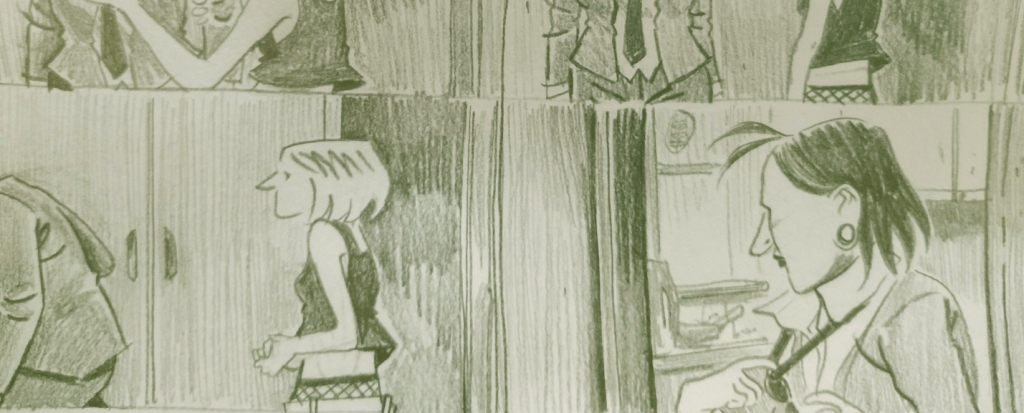
The great cartoonist Seth subtitled his brilliant Wimbledon Green with the words, “A story from the sketchbook of the cartoonist Seth.”
Wanting an excuse to make some fun comics just for himself, he decided to put aside a bit of time each morning to draw a little comic in his sketchbook. Without planning ahead, he drew what came most naturally to him, and gradually a story emerged, eventually ending up as the complete book.
I’m working on something with a similar approach: a graphic novel called Amy & Kay.
Every page of this comic is drawn without any under-drawing. It’s just me and a pencil, drawing it as I go along.
Working this way permits a lot of spontaneity to come out in the drawings. The standard way of drawing comics, and the way I’ve usually done it (as detailed in my last post), is to create a careful underdrawing and then ink over the top of it. This is a tried-and-true method that’s served people well for countless great comics, but the results can look a little overwrought, and lacking in the focus and emotional immediacy that a spontaneous drawing can give to a character’s expression and gesture.
When I noticed that a lot of my sketchbook drawings and doodles were stronger than my more careful illustrations, I knew I had to find a way to make my comics more like my sketches.
I’m quite deep into this book, and I’m starting to see the result: a story in pictures where the drawings may not be technically perfect, but where the immediacy of the drawing hangs together in a natural way and seems to give more life and character to the story than I’ve managed to acheive before.
More info on the book coming soon! Until then, here’s a few snapshots from the drawing board in the last few weeks.
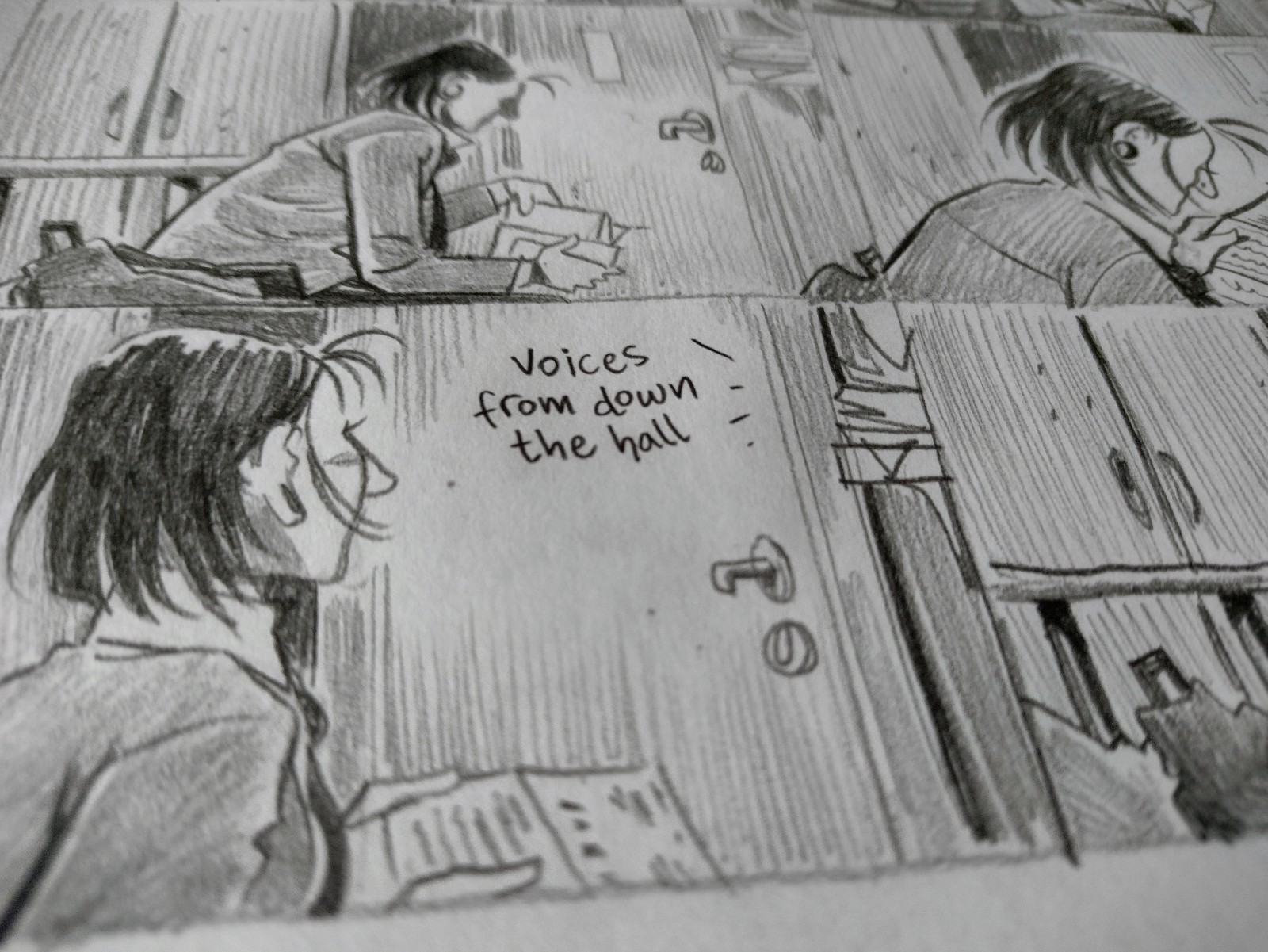



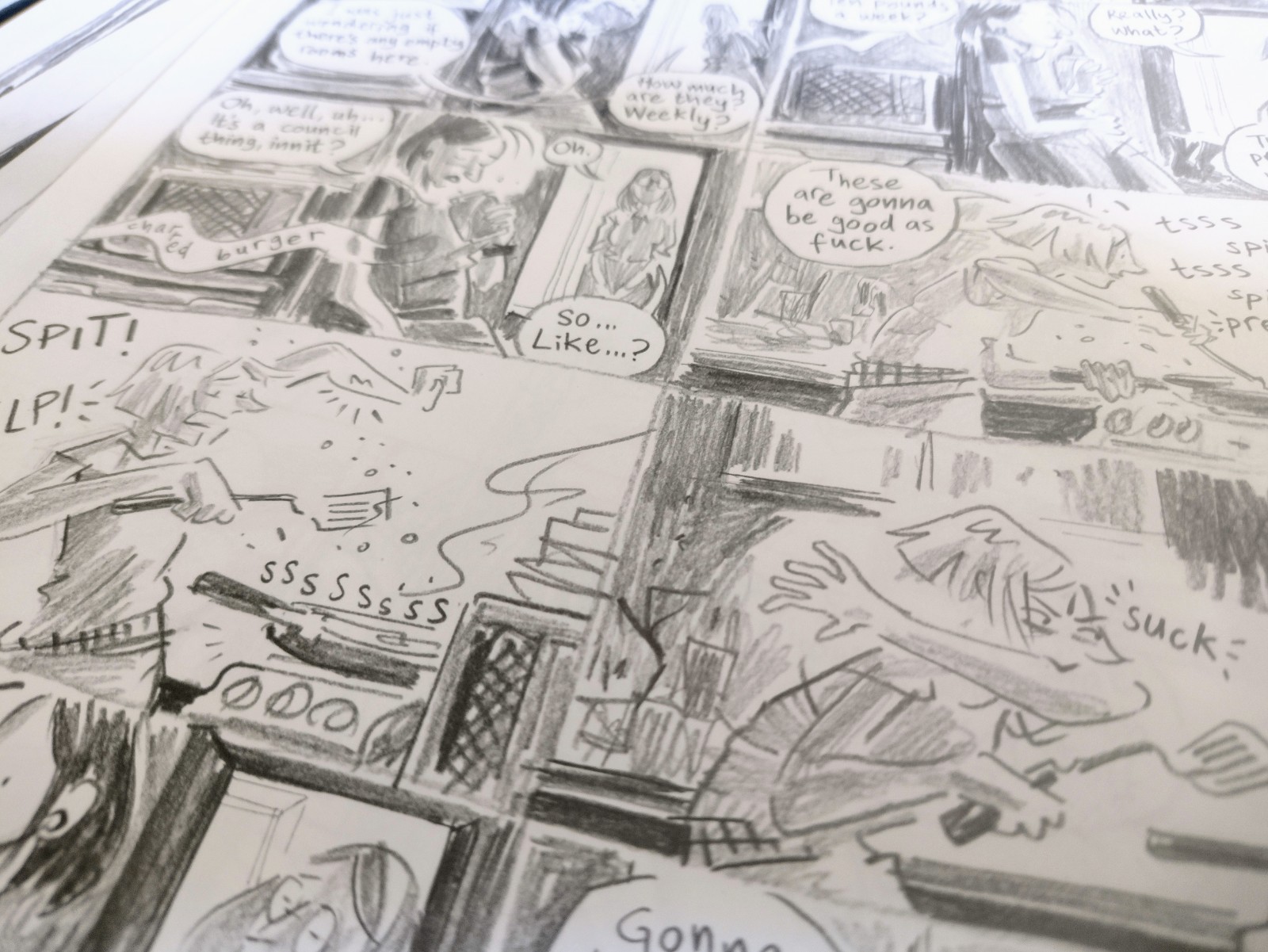
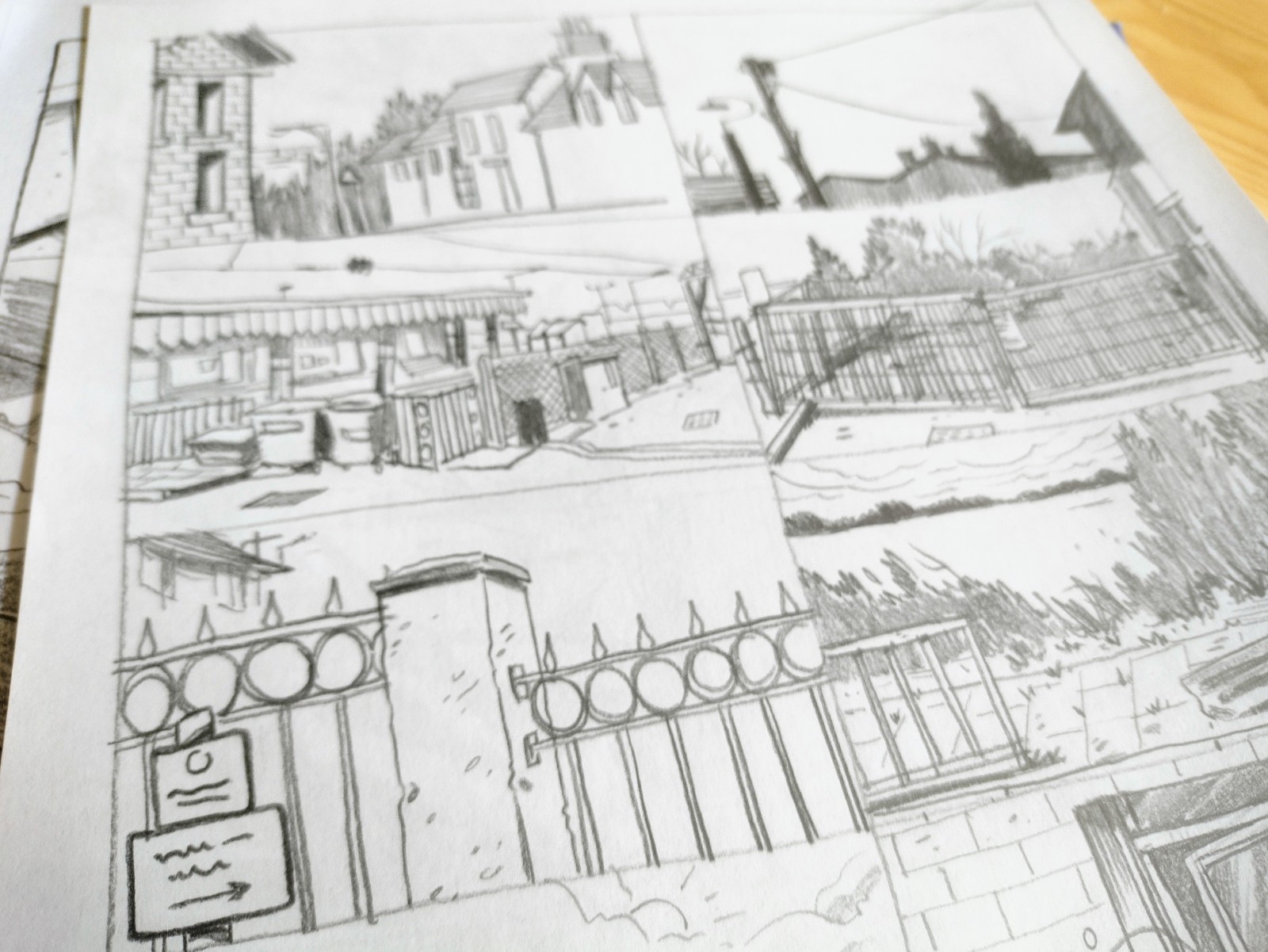

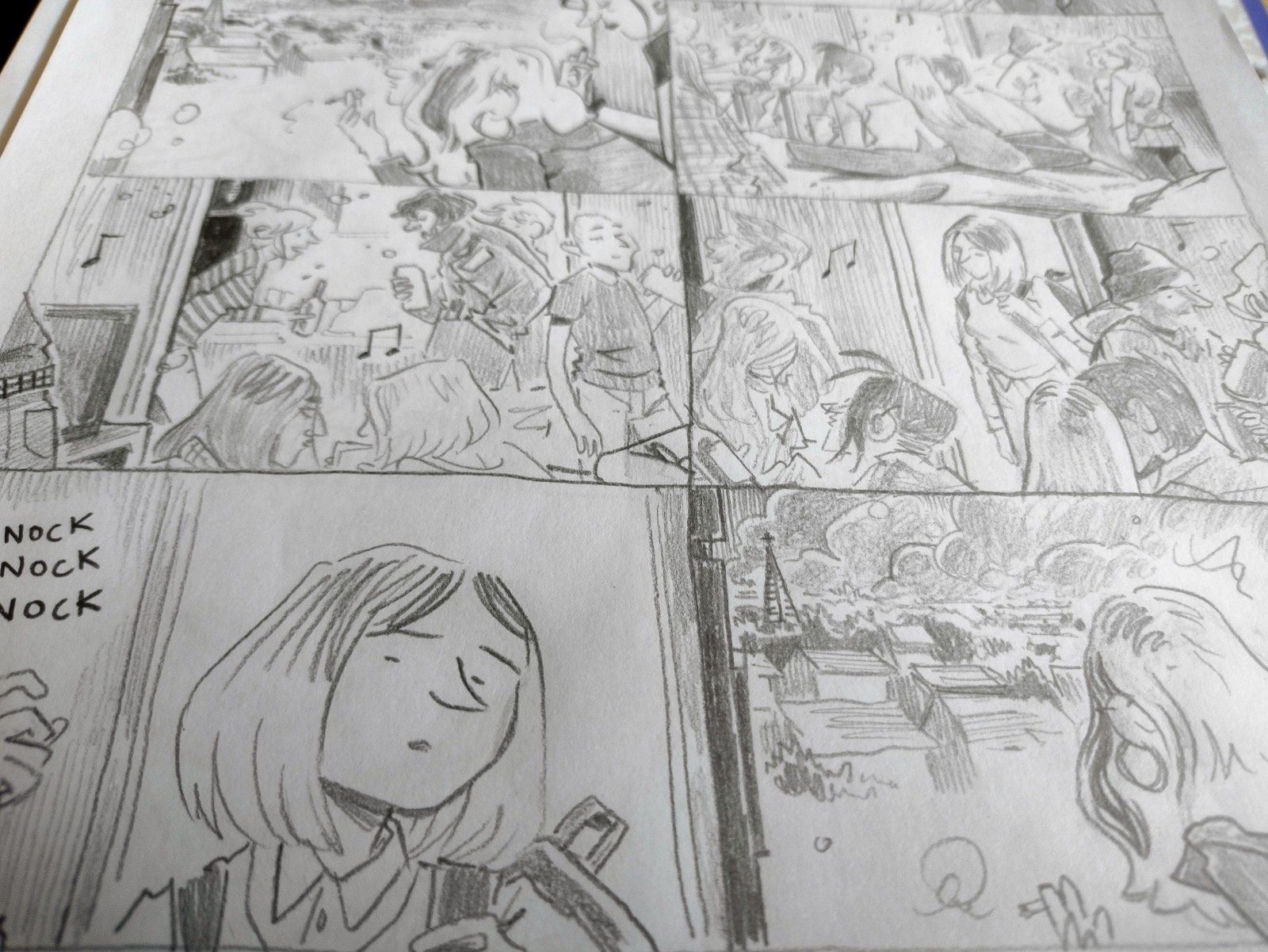
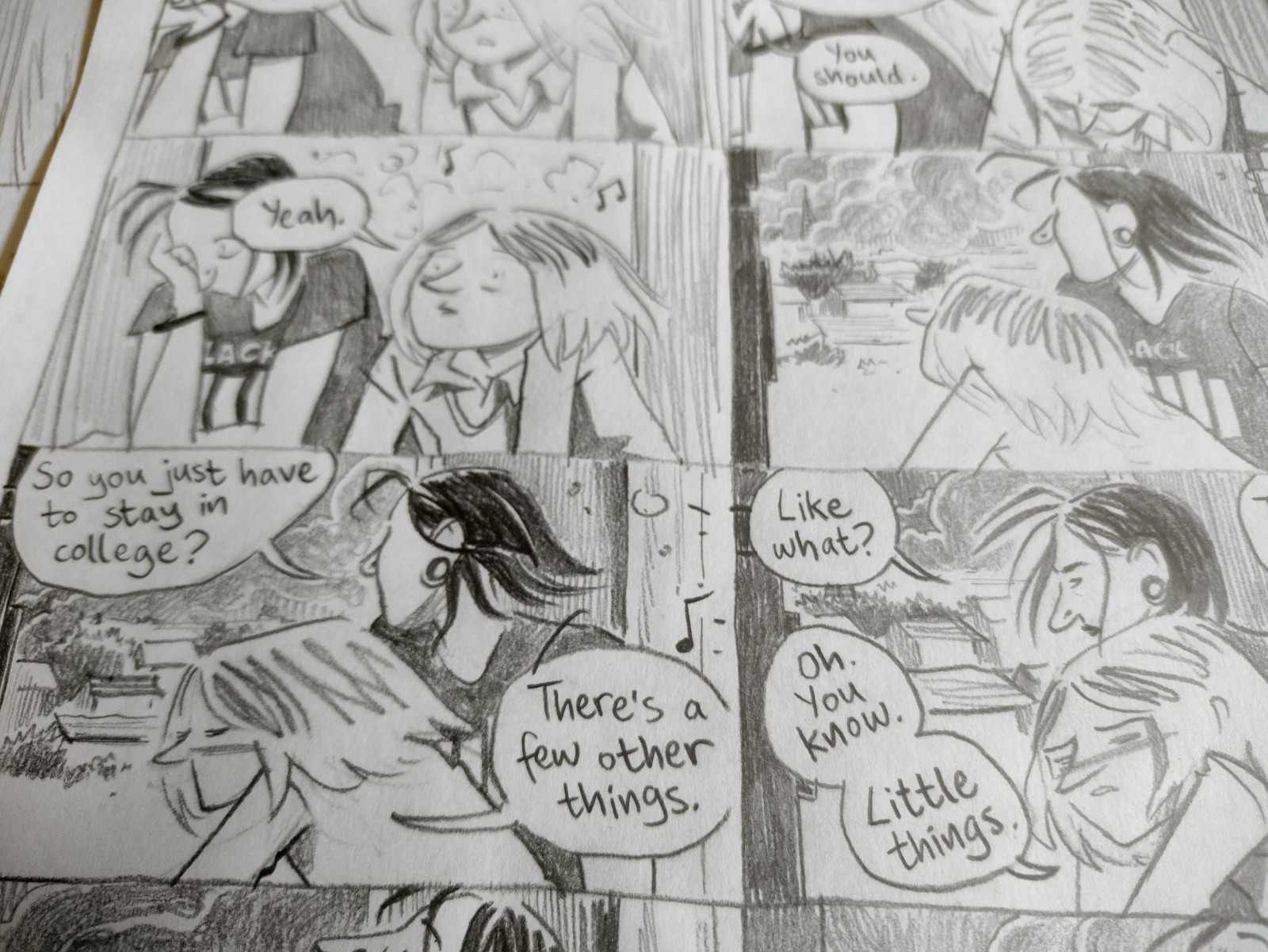
Filed under: illustrations | Tags: art, cartoons, children's books, comics, graphic novels, illustration, science

When I was giving school talks about Dino Detectives I spoke a bit about the process of going from script to full-colour artwork when making a page of comics. I thought I’d share here the examples that I used from the book, going from a script, to thumbnails, to scrappy roughs, to blue-line underdrawing, to the final line drawing. Then the process of layering the colour on, from background, to characters, then adding details, then shadows, and finally a few special lighting effects.











Filed under: illustrations | Tags: comics, graphic novels, illustration, science, sketch
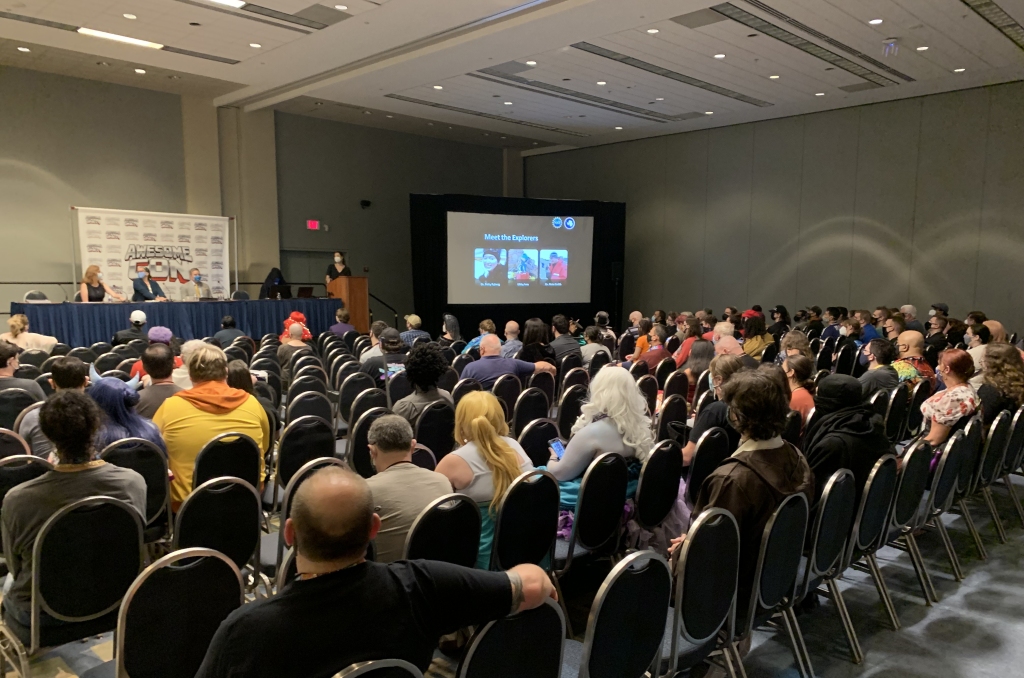
Big thank you to Washington DC’s Awesome Con for having me alongside Greg Neri to talk about our comic book, The Time Travelling Dino Detectives of Antarctica, releasing to coincide with the new big screen documentary, Dinosaurs of Antarctica, from Giant Screen Films.
We appeared via video along with a panel of scientists to talk about dinosaurs and comics, and also to show off some new drawings as answers to questions about life on the frozen continent (how do you take a shower in Antarctica?)
Attendees can take an epic journey back in time to a prehistoric world now lost to ice, with this sneak preview of the giant screen adventure, Dinosaurs of Antarctica. Meet the scientists, Libby Ives, Dr. Patricia Ryberg, Dr. Nathan Smith, G. Neri, and Corban Wilkin who explored the frozen continent’s glaciers on a quest to uncover its secret past, and learn how to draw a dinosaur with the award winning team behind the comic, “The Time Traveling Dinosaur Detectives of Antarctica.” (Panel details: “Dinosaurs of Antarctica” – 3:15PM – August 21 – Room 144AB)
https://geekinsider.com/awesome-cons-science-fair-brings-another-year-of-innovation-exploration-and-fun/
Huge thanks to Deborah Raksany from Giant Screen Films for organising this!

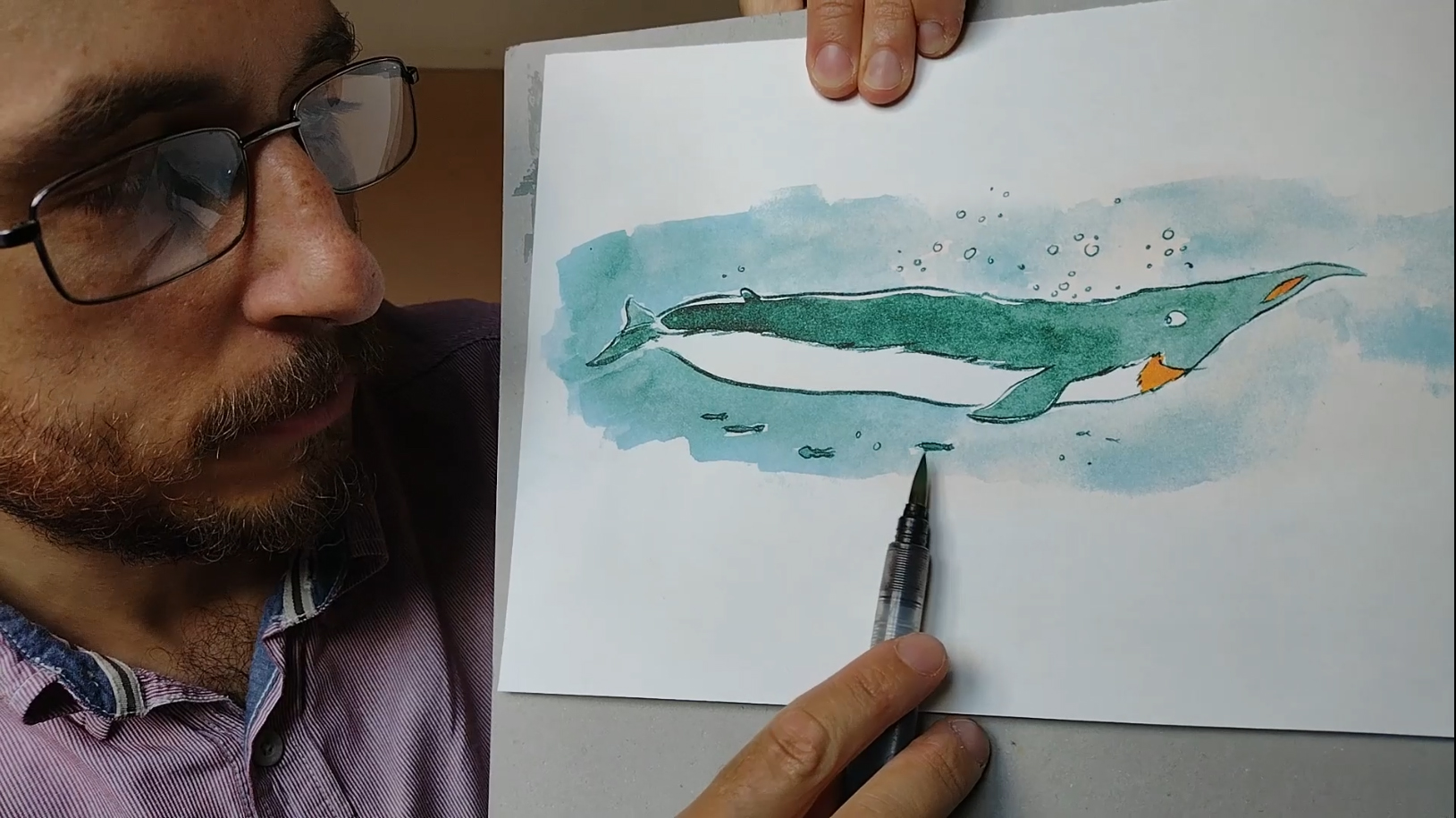
Filed under: comics, drawing, grand theft horse, graphic novels, illustrations, my comics | Tags: art, books, children's books, comics, drawing, graphic novels, illustration






Yes, that’s me up there, talking to a room full of people about drawing horses.
Last week I completed a schools book tour in Florida after Hillsborough County’s school libraries chose Grand Theft Horse as one of their Summer Slam books.
With Greg Neri, I did seventeen talks, and spoke about myself and my background in comics, the process behind creating Grand Theft Horse, and our upcoming project Time Traveling Dino Detectives of Antarctica. We also did book signings, prize giveaways, drawing lessons, posters, and more.
I met a lot of people, adults and kids alike, who were really enthusiastic about what we’re doing and are already looking forward to the new comic coming out.
Also, since it was my first time in Florida, I was grateful for the opportunity to see one or two alligators, swim in the Gulf, eat some key lime pie, and many other very cool Floridian things.
I’d like to say many thanks to Greg and his family, and to the brilliant Kimberly DeFusco for organising the trip. Also to all the great librarians in Hillsborough County for hosting us at their wonderful schools.

Filed under: drawing, drawing theory, illustrations, sketchbook | Tags: art, drawing, illustration, life drawing

Recently, I took a small sketchbook and a pencil to Devon.
In drawing landscapes and scenes from life I’ve been thinking in terms of ways of handling particular visual elements, i.e. how do you make sense of the world in front of you and actually have your drawing appear immediately to the eye as being the view you were looking at?
You’d think it would be simple. If you just draw what’s in front of you accurately then you’ll end up with a good facsimile of what you were looking at, surely. This is often true with highly skilled impressionistic painters, dabbing carefully chosen colours onto the canvas, and literally getting down what their eyes see until gradually it builds up into a coherent image. But for many types of drawing and painting simply getting down exactly what you see is not enough. More than that: it doesn’t work.
Say you’re drawing with nothing but a grey pencil on white paper. You sit down to draw a landscape. You see an area of bright white sand next to an area of dark rock in shadow. This doesn’t present any real problems. Leave the area of sand mostly white on your page, and make the rocks very dark. But then you look up, and above the sand is the sky. The sky is neither light nor dark: it’s bright. And it’s very distinct from both the sand and the rocks. You’ve already used a light area and a dark area, so do you put the sky down as a mid-tone? That doesn’t really work, it’s too bright. It should be white on the page. But the sand is white on the page, already. So you end up drawing a dark line of pencil to show the line where the sky and the sand meet, even though that line isn’t there in real life. You might even see someone’s lime-green windbreaker or hot-pink parasol against the sand and the sky, and those will have a different quality again.
These are the things I’m trying to find ways to handle when sketching recently. A drawing is not the same thing as real life, and I’m trying to find methods to interpret things so that they communicate on the page. I’m trying to define shapes of certain qualities, colours and textures so that they are immediately distinct. It’s all too easy for a pencil sketch of a scene to devolve into a mess of lines, where everything has the same quality and nothing stands out from anything else, because I’ll have tried to draw everything in the same way, just marking down what I see. But by using defined areas of pattern and tone, and differentiating objects and areas by using varying qualities of line, and by treating identifiable objects as separate and clearly-defined against what’s behind them, I’ve been able to get a lot more clarity than I usually do out of some very simple pencil sketches.
Filed under: drawing, drawing theory, illustrations, sketchbook | Tags: art, drawing, illustration, life drawing, sketch
Can you learn new things unconsciously?
Skills like riding a bicycle aren’t really skills until you can perform them subconsciously. No-one can ride a bike well if they have to think consciously about the movement of each arm and each leg, and consciously keep balance and so on. You’re not really riding until you’re doing it without thinking about it.
I’ve been doing a lot of life drawing recently, and I’ve started to notice a distinct pattern in the quality of my drawing.
Here’s how it goes: sometimes I tell myself to buckle down and really concentrate on executing a careful, tightly-observed drawing, taking note of as much as possible, and relating as many areas to as many other areas as I can. What usually happens when I do this is that I do some interesting bits of drawing; some novel local observations, but I do not do a good drawing, which is to say, a good, whole drawing; the parts do not hang together into something harmonious.
Usually the drawings I produce when I focus very consciously in this way make me frustrated because they end up being ugly to look at and I can see how unsuccessful they are at capturing the person I’m drawing, so after a few of these perceived failures I tend to stop focusing and relax into drawing very quickly; more quickly than I can think; letting my hand take over from my brain; drawing subconsciously. Almost invariably when I do this, I end up producing quite nice, harmonious drawings and it gives me a lot of pleasure to do. Additionally, it takes little energy; indeed, I often end up invigorated after drawing this way; I feel full of energy, as though I could draw all night.
So what’s the problem? Just draw subconsciously, right? By delegating responsibility to my hand, my subconscious understanding of drawing takes over and makes things easy. But I started to think about this, and it occurred to me to ask: how did I gain that subconscious ability to draw? Because I didn’t always have it. Surely it must have been through the struggle of drawing consciously, and so paying attention to things very closely and actively and, through long, difficult work, committing the knowledge that I picked up consciously to my subconscious.
It makes me wonder: when I draw in this nice, very enjoyable, subconscious way, am I learning anything? Or do I only learn new things and improve my drawing by doing the difficult thing of being fully-aware and drawing consciously? And isn’t life-drawing, when you’re trying to learn rather than create your best, illustrative work, the time to do that?
Filed under: comics, graphic novels, illustrations | Tags: art, books, children's books, comics, graphic novels, horses, illustration, writing
After a long hiatus, I’ve just finished drawing the gigantic project with G.Neri (author of Tru & Nelle), that’s been ongoing for some time. I’ve generated a four-inch-thick stack of pages with roughly the heft of a small child. Still much to do, but the complete, unedited thing is there, in a big box under my desk.
